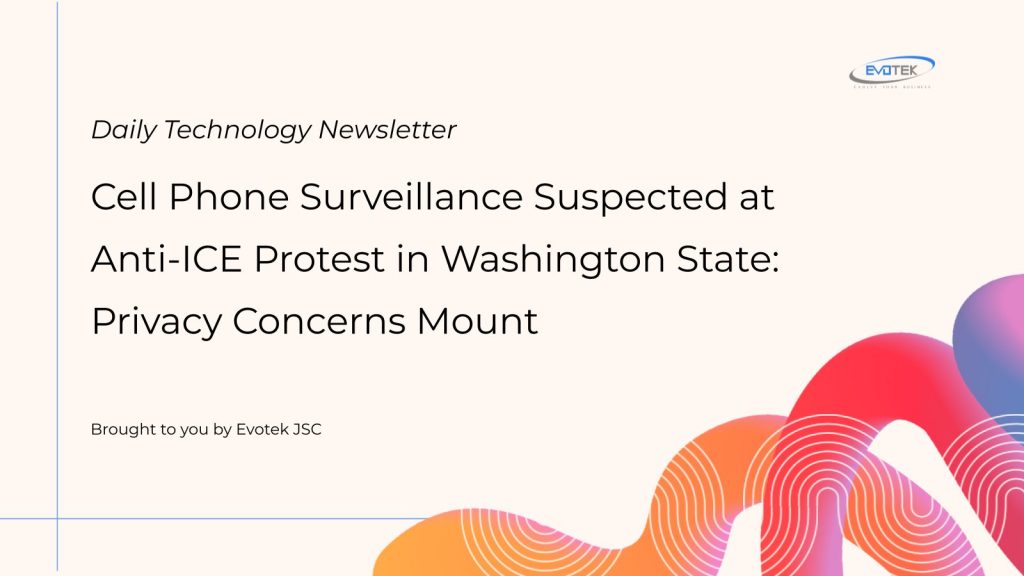An independent analysis of cellular traffic has uncovered compelling evidence suggesting the use of cell phone surveillance technology at a July 4th protest held outside an Immigration and Customs Enforcement (ICE) field office in Washington state. The detected mobile network anomalies are consistent with the deployment of an IMSI catcher, a device capable of gathering identifying information from mobile phones.
The findings, reported by Straight Arrow News following a specialized analysis, indicate that a device commonly known as a “Stingray” may have been utilized. This raises significant questions regarding the privacy of protesters and the legal basis for such surveillance activities, particularly given that ICE has not responded to inquiries regarding a warrant for the device’s use.
What is an IMSI Catcher and How Does it Work?
An IMSI catcher operates by mimicking a legitimate cell tower, forcing nearby mobile phones within a significant radius (up to a third of a mile) to connect to it. Once connected, the device can trick phones into revealing their International Mobile Subscriber Identity (IMSI) – a unique 15-digit number tied to a phone’s SIM card. This IMSI can then be used by law enforcement and intelligence agencies to pinpoint the location of a specific phone or to identify all phones present in a particular area.
Beyond location tracking, more sophisticated IMSI catchers can compel cell phones to downgrade to less secure network protocols (like 2G), potentially enabling the interception of unencrypted text messages and phone calls. While primarily used by authorities, the technology’s components and software are publicly available, making it accessible to criminals who could use it to deploy malware or compromise sensitive data.
Independent Analysis Reveals Suspicious Activity
The independent investigation focused on LTE cellular traffic at the anti-ICE protest in Tukwila, a Seattle suburb, utilizing a cutting-edge tool named “Marlin.” Developed by mobile security experts at the University of Florida and ETH Zurich, Marlin is designed to detect irregularities indicative of surveillance devices.
Researchers observed unusual bursts of data, specifically “IMSI-exposing messages,” across several LTE frequency bands. Typically, cell networks provide phones with Temporary International Mobile Subscriber Identities (TIMSIs) for enhanced privacy, and legitimate cell towers rarely request a phone’s permanent IMSI. However, at the protest site, anomalous behavior was detected starting at 9:06 a.m. on July 4th, shortly after monitoring began, with a burst of 57 IMSI-exposing commands. Subsequent bursts appeared roughly every 10 minutes over the next hour, triggering numerous real-time alerts from the Marlin tool. A post-scan analysis confirmed a total of 574 IMSI-exposing messages.
The analysis also flagged two “attach reject” messages, a type of cellular rejection that can occur when a phone attempts to connect to a network. While valid reasons exist for such messages, their rarity on properly configured networks and their timing at the height of the protest (9:55 a.m. and 10:04 a.m.) are suspicious, as IMSI catchers may use them to block or downgrade connections before encrypting IMSIs.
To validate these findings, a follow-up scan was conducted at the same location and time the following day, when no protest was taking place. Crucially, Marlin issued no real-time alerts, and no anomalies were detected during multiple field tests in high-traffic urban environments a week prior to the protest. According to Patrick Traynor, a professor at the University of Florida and one of Marlin’s inventors, the high number of IMSI-exposing messages during the event, especially when compared to the control scan, is “strongly suggestive of the presence of an IMSI-catching device.”
Legal and Civil Liberties Concerns
The potential use of IMSI catchers at a protest raises significant civil liberties concerns. Federal law enforcement agencies are generally permitted to use these devices without a warrant only under “exigent” or “exceptional circumstances,” such as immediate threats to national security or imminent danger to life, as outlined in a 2023 report by the Department of Homeland Security’s (DHS) inspector general.
The same inspector general’s report previously found instances where ICE’s Homeland Security Investigations unit and the Secret Service had used such surveillance devices without proper court authorization. The American Civil Liberties Union (ACLU) has voiced strong opposition to the use of Stingray devices against individuals exercising their First Amendment rights.
Nathan Freed Wessler, deputy director with the ACLU’s Speech, Privacy and Technology Project, emphasized that courts have consistently held that this invasive technology should only be used in limited circumstances after a valid warrant is secured. He stated that “If evidence were to show these devices being targeted at protesters, the government would have a lot to answer for.”
Protest Context and Advocacy
The July 4th demonstration in Tukwila, organized by Southend Indivisible, a local affiliate of the national Indivisible organization, was a smaller, more peaceful event compared to a previous protest on June 14th. That earlier demonstration had seen clashes with local police, including the use of pepper spray, and vandalism at the ICE facility.
Josh Castle, the chair of Southend Indivisible, expressed alarm over the potential surveillance, stating, “ICE under Trump more closely resembles a secret police force in an authoritarian regime… than a legitimate agency within a co-equal branch of government accountable to voters in a constitutional democracy.”
Why This Story Matters
The detection of potential cell phone surveillance at a constitutionally protected protest highlights critical issues:
- Privacy Rights: It underscores the growing capabilities of law enforcement to collect mobile phone data and the inherent risks to personal privacy.
- Civil Liberties: Concerns persist about the targeting of individuals participating in protests, emphasizing the vital need to safeguard First Amendment rights against unwarranted government surveillance.
- Law Enforcement Accountability: The lack of transparency regarding warrant procurement, coupled with past reports of unauthorized surveillance, fuels a broader public debate about oversight and accountability in the deployment of advanced surveillance tools by authorities.
The investigation into these mobile network anomalies continues, as the implications for digital privacy and civil liberties in the age of advanced surveillance technology remain a paramount concern.

 日本語
日本語 한국어
한국어 Tiếng Việt
Tiếng Việt 简体中文
简体中文